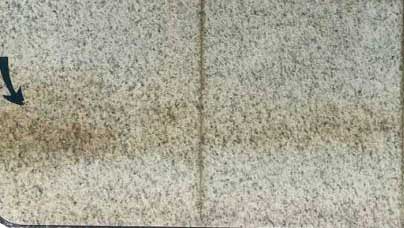Granite
Defect and Repair
| Granite | Defect | Repair |
|
|
Staining May be caused by the natural property of the stone, efflorescence of the precast concrete backing, sealant used and other factors. |
Cleaning by water coupled with scrubbing or high-pressure water jet could effectively remove most of the stain from the stone cladding surface.
Cleaning should begin at the top so that excess water can run down and pre-softens the dirt below. Acidic cleaning agents should not be used for granite as it attacks pyrite (iron sulphide) |
|
Cracking Cracks across the span of the marble strip were found mainly at the corners. 1.Inadequate control joint 2.Tiles over moving cracks 3. Cutting and poor handling 4. Direct impact 5. Damaged by other trade after laying if unprotected 6. Inherent characteristics of stones such as natural veins, i.e. stylolites 7. Excessive external vibration |
To replace the affected panel by a new one and provide sufficient cushion to absorb various stresses created by the deformation of the structural frame, differential thermal movement between the concreter baking and the panel, or the accidental external impact load.
Hairline crack can be filled with epoxy resin, and re-polish the surface. |
|
|
|
Organic growth | Can be removed dry with wooden scrapers and/or brittle brushes or may be removed using high-pressure water lance. In all cases, the cleaned surface should be treated with a suitable and approved anti-fungal wash. |
Note: For more defects, please refer to the Defect Library.
The method of repair should comply with CP 67 Part 1:1997 Code of practice for cleaning and surface repair of buildings – Natural stone, cast stone and clay brick masonry.

